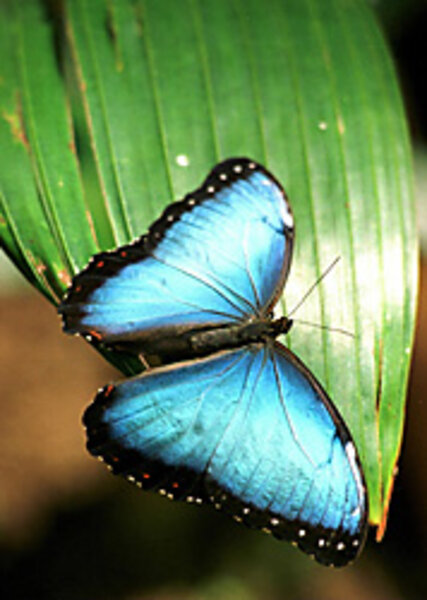A blue wonder to remember
"Mariposa, mariposa," a young man with a beaming smile kept saying emphatically while pointing in the general direction of dense green foliage studded with bright red blossoms. Even with my very limited Spanish vocabulary, I knew that mariposa meant butterfly. But why all the excitement? There were hundreds of colorful butterflies in Costa Rica, all over, all the time.
"Mariposa," the man kept insisting and pointing. Until finally I spotted it: shimmery, electric blue, with a six-inch wing span, flitting gracefully through tropical lushness. "It" was a Blue Morpho butterfly, or Morpho peleides.
"Morpho," of Greek etiology, was an epithet applied to Aphrodite (Venus), goddess of beauty. And the Morpho butterfly, I can confirm, truly lives up to its name.
A naturalist friend had told me about these beautiful butterflies, but upon my first actual sighting, they still took my breath away. Even for a place like Costa Rica, where all of nature is "extra" – extra big, extra colorful, extra exotic – this creature was magnificent.
We made our way from rain forest to volcano to Pacific coastline, and I sometimes saw a few of the magical Morphos mounted in glass-enclosed display cases for sale.
How nice it would be to take one home, I thought. To look at again and again, to keep forever a piece of Costa Rica's splendor. It's always difficult to encapsulate the special awe and beauty of a place. Postcards and posters are nice reminders but can never quite capture the real thing.
Oliver Twist (in the movie version of Dickens's timeless tale), apparently thought along similar lines. In a bustling city scene, he gazes out his London window and sings: "Who will buy this wonderful morning? Such a sky I never did see. Who will tie it up with a ribbon, And put it in a box for me? So I could see it at my leisure, Whenever things go wrong. And I could keep it as a treasure, To last my whole life long."
A preserved piece of nature's beauty can go a long way in lighting up a gloomy day.
I picked up one of the mounted Morphos for a closer look at the delicate details. Dark veins formed a lacy network on the iridescent blue-green wings edged with brown. Everything seemed to glow. I would buy one, I thought, on the last day of our trip.
We continued traveling through one marvelous habitat after another, containing ever more unbelievable birds and mammals, plants, and reptiles. Finally, on the last afternoon of our stay, we went to a large souvenir shop, for a quick hour's gathering of obligatory gifts for the folks back home. (Who could waste more time shopping while the glories of Costa Rica beckoned outside?)
I went to look for my Morpho butterfly. There they were, displayed on a long shelf. Each beautiful blue insect sparkled under its glass cover, surrounded by a pretty wooden frame. I picked one up and gazed at its exotic beauty. It called to mind all the butterflies soaring in the sun between giant leaves and flamboyant flowers, alive and vibrant, flying free in their natural home. How different they seemed from these immobile bits of brilliant color encased in glass and wood.
Somehow, something didn't feel right.
There are plenty of preserved animals and plants in the natural history museums I've always loved, vast collections of flora and fauna from around the world. They, too, are stilled forever, far away from their natural homes.
But were it not for these museums, I had always told myself, only a limited number of people would get the opportunity to see them. Some of these many marvels from remote corners of the globe are now extinct and would remain unknown and unappreciated had they not been so preserved.
On the other hand, these permanently preserved creatures had been killed and removed from their native homes.
Then again, in their state of preservation, countless people could study them and learn, could taste the wonder and awe.
Even so, I thought, they belonged in the wild from whence they came.
But what about the argument that even in their lifeless state, they might inspire reverence and respect, so more of nature's beauty could ultimately be protected in the wild?
The "buts" and "on the other hands" kept ricocheting back and forth. I was of two minds, and the minds weren't meeting. There were valid points on both sides.
Once again I looked at the glistening Morpho butterfly in my hand – and carefully put it back on the shelf.
There's a sign at the entrance to one of the rain forests through which we had hiked: "Take nothing but pictures. Leave nothing but footprints. Bring nothing but memories."
And so I took home my very own Morpho butterfly – in amateur sketches and handwritten journal notes, in vivid memory – safe and sound, flitting gracefully amid the lushness of gigantic green leaves. A place it would shimmer and shine, flying free, forever.





